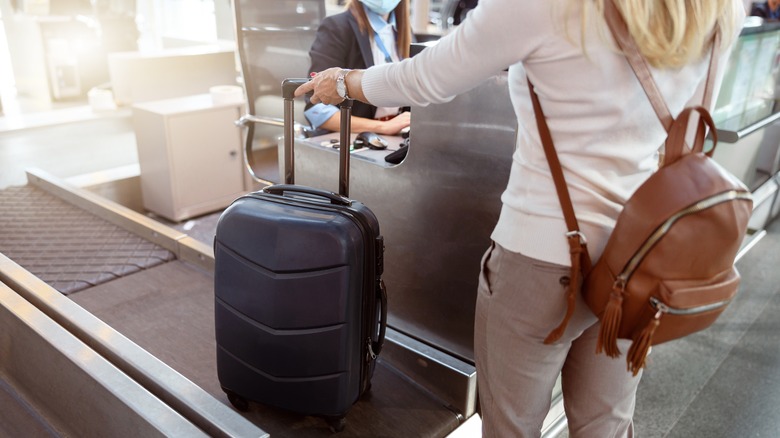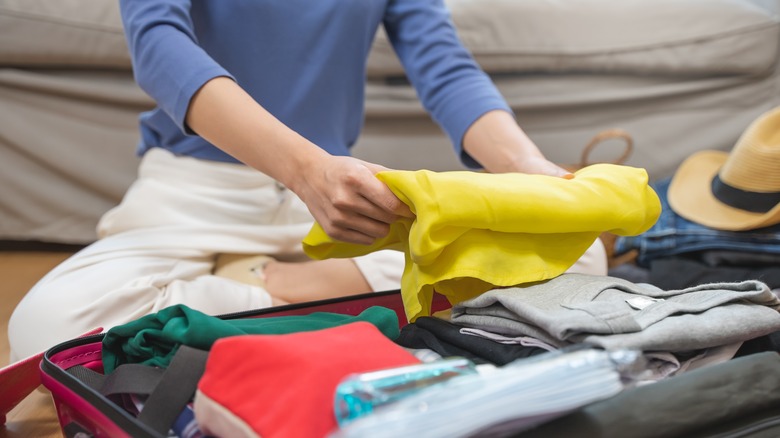Does The Sticker Hack Really Work To Keep Checked Luggage Safe?
Opting to check your luggage often feels like a gamble since you have no way of predicting its fate. The moment you deposit it at the self-service bag drop kiosk or hand it over to the busy check-in attendant to place into the mysterious conveyor belt, you just have to hold on to all hope that it will return to you in one piece. The sad truth is checked baggage, no matter the size or the kind, isn't always handled delicately (if at all) throughout its journey from your hands to the baggage carousel — even if it's slapped with a giant fragile sticker.
There even appears to be a misconception that affixing a fragile label on a checked bag means it will get special treatment from bag handlers. In a viral video, TikTok user @royceandrocket noted that doing so can potentially reduce your waiting time at baggage claim. "Bags marked as fragile will typically be loaded later, so they aren't crushed and potentially come out before the other bags," they wrote. "Plus, they're also likely to be handled with more care."
Ah, if only it was that easy, right? Unfortunately, with the number of bags airport staff and baggage handlers deal with, fragile stickers are rarely taken into consideration. Just because you have the word "fragile" on your luggage in big, bold letters doesn't mean it will really be treated as such.
Bag handlers may not notice fragile stickers
Once your luggage joins the hordes of other bags, fragile stickers may as well be invisible. In an anonymous interview, an airline baggage handler admitted to Fox News that more often than not, they don't "handle" — they "throw." In other words, they're often racing against the clock, so they tend to focus more on speed than delicacy.
"I'm not going to lie, your checked luggage takes a beating," he said. "Due to the nature of some aircraft, it would be impossible to turn around a 737 or 757 in an hour or less without throwing bags because it's just faster." And as for the fragile sticker? It doesn't always command the attention it deserves due to the chaotic nature of airport logistics. "Those fragile stickers don't get noticed very often in the rush of loading bags unless it is an obvious shape, such as a musical instrument."
However, when staff do see fragile stickers, the bags need to fit certain criteria to warrant special handling, according to another baggage handler named Zack via Condé Nast Traveler. They have to be current, airline-specific, and properly placed. "... if the bag has a fragile tag that looks old or is from a different airline, then it's as good as expired," he noted. "Obviously, we're looking for tags or stickers issued by our airline and located on the handle, near the checked tag. If there's no current, valid tag, then it's like any other bag."
How to keep your checked luggage safe
If you want your checked luggage to return to you unscathed, even after getting thrown around hastily, select the proper type of bag. You'll want to opt for a hard case rather than a soft one because they are better equipped to endure shock. "Hard shells tend to distribute the forces, whereas a soft shell will localize the load," Jose Andrade, professor of mechanical and civil engineering at Caltech, told The Points Guy.
You also want to avoid placing fragile items inside, but if you have no choice, Andrade suggests using bubble wrap, Styrofoam peanuts, or even socks for protection. "What really matters is putting wrapping around your fragile objects so they can dampen the loads and break those force chains coming from outside," he advised. "Put fluffy stuff to absorb the energy, and that will transmit very little energy to the next object."
To cover all your bases, you may also want to buy baggage insurance. Some companies sell policies that cover up to $3,000 in damages, making them a worthwhile consideration if your luggage is packed with valuables. But Zack advises that you have to take action ASAP should you wish to make a claim. "You've got to take care of it right away, even if you're cranky and reek," he told Condé Nast Travel. "This stuff cannot be done after the fact, and you need the documentation, no matter if you later deal with the airline or your own insurance."

